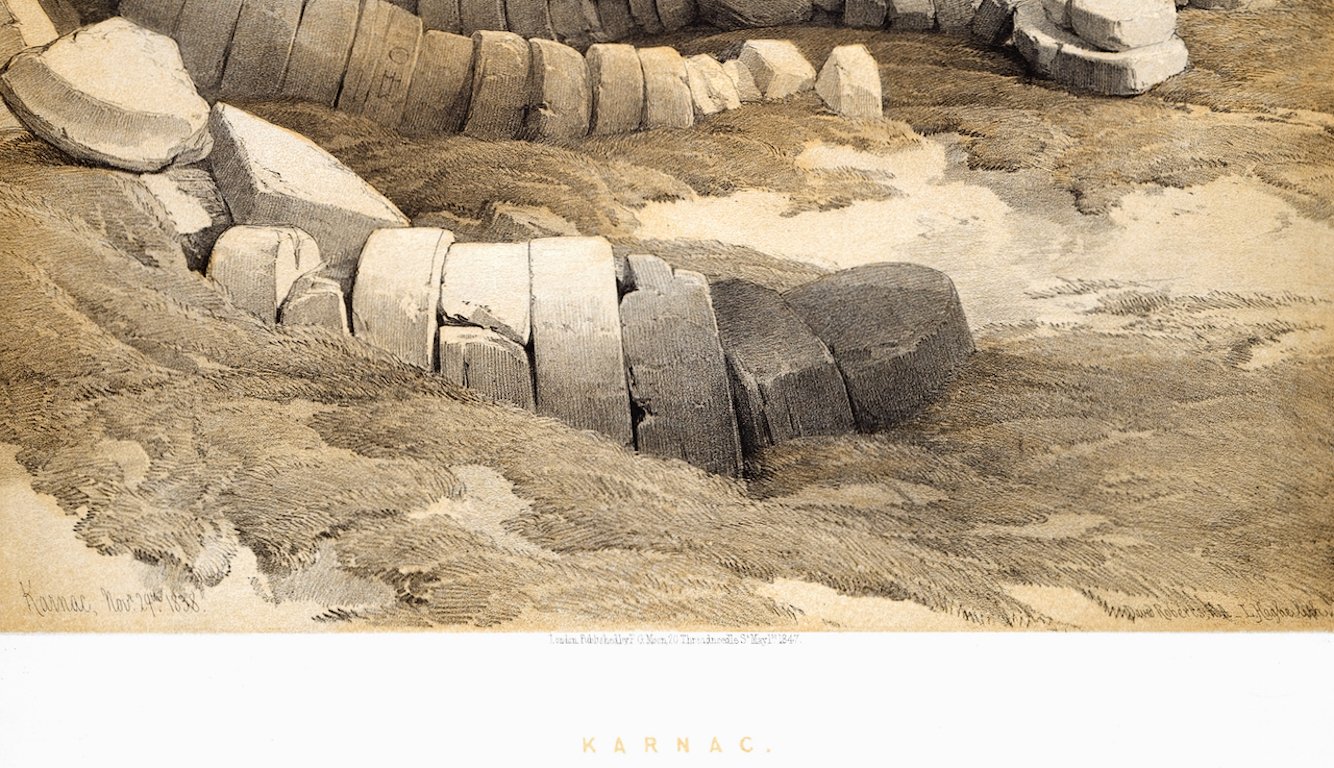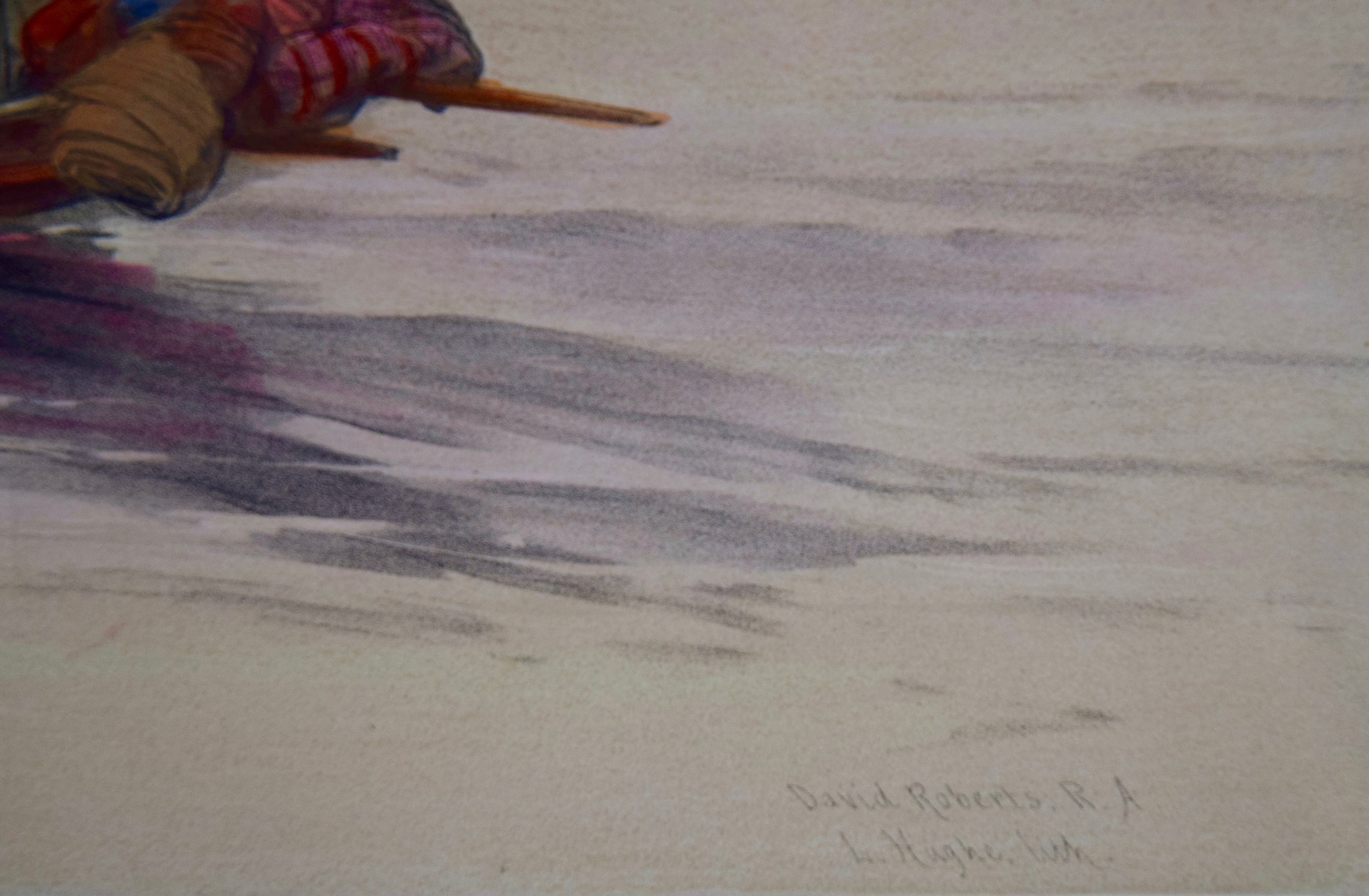Karnac, Egypt, Nov. 29, 1838: David Roberts' 19th C. Duotone Lithograph
This is an original 19th century hand-colored lithograph entitled "Karnac, Nov. 29, 1838" by David Roberts, from his Egypt and Nubia volumes of the large folio edition, published in London by F. G. Moon in 1847. The lithographs were prepared by Louis Haghe (1806-1885) from drawings and paintings by Roberts. The resultant large folio editions of 'The Holy Land' and 'Egypt & Nubia' are considered the greatest lithographically illustrated works issued in the 19th century.
Creator: David Roberts (1796-1864, British)
Creation Year: 1847
Dimensions: Height: 24 in (60.96 cm)
Width: 17 in (43.18 cm)
Medium: Lithograph
Condition: See description below.
Reference #: 4682
This is an original 19th century hand-colored lithograph entitled "Karnac, Nov. 29, 1838" by David Roberts, from his Egypt and Nubia volumes of the large folio edition, published in London by F. G. Moon in 1847. The lithographs were prepared by Louis Haghe (1806-1885) from drawings and paintings by Roberts. The resultant large folio editions of 'The Holy Land' and 'Egypt & Nubia' are considered the greatest lithographically illustrated works issued in the 19th century.
Creator: David Roberts (1796-1864, British)
Creation Year: 1847
Dimensions: Height: 24 in (60.96 cm)
Width: 17 in (43.18 cm)
Medium: Lithograph
Condition: See description below.
Reference #: 4682
This is an original 19th century hand-colored lithograph entitled "Karnac, Nov. 29, 1838" by David Roberts, from his Egypt and Nubia volumes of the large folio edition, published in London by F. G. Moon in 1847. The lithographs were prepared by Louis Haghe (1806-1885) from drawings and paintings by Roberts. The resultant large folio editions of 'The Holy Land' and 'Egypt & Nubia' are considered the greatest lithographically illustrated works issued in the 19th century.
Creator: David Roberts (1796-1864, British)
Creation Year: 1847
Dimensions: Height: 24 in (60.96 cm)
Width: 17 in (43.18 cm)
Medium: Lithograph
Condition: See description below.
Reference #: 4682
The print depicts a view of the imposing Temple of Karnac located along the Nile River in Egypt. Egyptian men conversing at the base of a large column on the right provide a perspective as to the mammoth size of the structure. The huge temple with its ornate columns, hieroglyphics, and elaborate carvings is seen in the background behind fragments of fallen columns in the foreground. The date of David Roberts visit to Karnac, Nov. 29, 1838 appears in the plate in cursive in the lower left. David Roberts signature and that of the lithographer, L. Haghe appear in plate in the lower right and the publisher, G. Moon, London address and date of publication appear in the center of the lower margin and below that to name "Karnac".
Karnac is known today as Karnak. It represents a massive temple complex along the Nile River adjacent to Luxor. Construction of the complex began during the reign of Pharaoh Senusret I in the Middle Kingdom around 2000 BCE. Construction continued into the Ptolemaic Kingdom (305-30 BCE), although most of the surviving buildings are from the New Kingdom.
This hand-colored lithograph print is printed on wove paper with wide margins. The sheet measures 24" high and 17" wide. There is a small faint spot in the lower right margin, but the print is otherwise in excellent condition.
Provenance: This exceptional lithograph was previously owned by George Edwin Bergstrom, architect for the Pentagon.
The drawings and watercolours from Roberts' tour of the Holy Land and Egypt were collated together into folios and released over a seven year period by the publisher F.G. Moon from 20 Threadneedle Street London. This lithograph is from the Royal Subscription Edition (1842-1849) with only 500 copies produced per depiction. Louis Haghe (the Belgian engraver and friend of Roberts) worked on all of the lithographs for this series.
David Roberts (1796-1864) was born outside of Edinburgh, Scotland. At age 10 he became a house painter’s apprentice. He continued painting houses and eventually theater scenes in Edinburgh and then in London. His friend, J. M. W. Turner, recognized his artistic talent and encouraged him to become a full-time artist.
In 1839 Roberts traveled to Egypt and then in 1840, through the Holy Land, concluding in Jerusalem. Upon his return to England, F. G. Moon agreed to publish lithographs created by Louis Haghe from Robert’s sketches and watercolors. This publication was highly acclaimed and very popular for its esthetic quality, its historical and topographical accuracy, and Robert’s dramatic depiction of his scenes. Queen Victoria and Charles Dickens were among the subscribers who collected his works. Roberts' and Haghe’s duotone lithographs, often colored, remain extremely sought-after today and have been rising steadily in value.
































